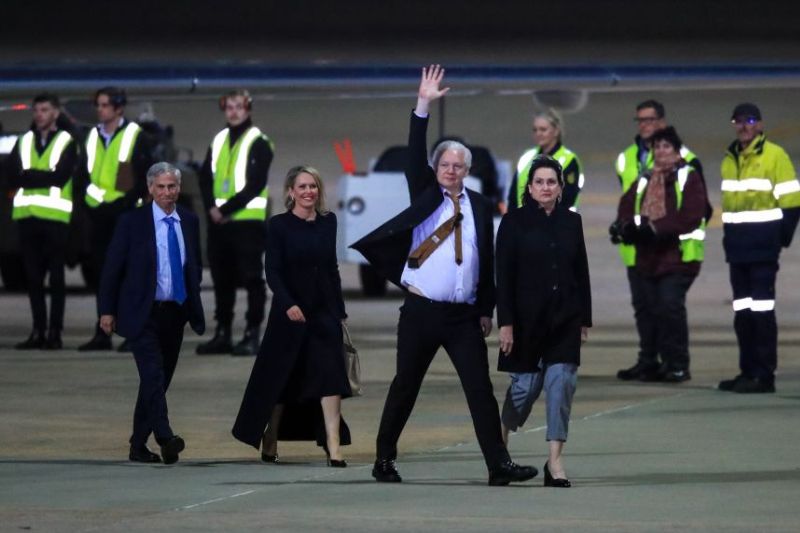Cue the scenes. Man of notoriety, moving on tarmac to plane. Inscrutable, he almost struts. Some hours prior, he had been in Britain’s most forbidding maximum-security facility. Spanning a mere few days, the WikiLeaks founder, Julian Assange, had left Belmarsh Prison in London, received bail, conveyed to Stansted airport and placed on flight VJ199. His wife, Stella, was fastidiously updating her followers on the flight details.

On route to Australia, Assange paid the briefest of visits to Saipan, located in the US commonwealth territory of Northern Mariana Islands in the Western Pacific. The purpose: to face a third indictment from the US Department of Justice on a non-continental territory. (Assange had demanded as much.) Before US District Court Chief Judge Ramona V. Manglona for the Northern Mariana Islands, the publisher pleaded guilty to one count of conspiracy to obtain and disclose national defence information under the US Espionage Act of 1917, or section 793(g) (Title 18, USC). Assange’s time in Belmarsh Prison, lasting 62 months, was accounted for as an adequate penalty.
The single count replaced the June 2020 superseding indictment charging Assange with 18 offences, one based on computer intrusion and 17 clumsily drawn from the Espionage Act. Had Assange been found guilty of the charges, a prison time of 175 years was in the offing.
The interest of US authorities in Assange dates back to September 2010, when 250,000 cables from the US State Department were published on the organisation’s website. To that could be added 90,000 activity reports on the US war in Afghanistan, 400,000 activity reports on the US-led invasion of Iraq, and 800 Joint Task Force Guantanamo (JTF GTMO) briefs on detainees. Such material disclosed alleged war crimes, alleged instances of torture, and, perhaps most damningly for the critics of WikiLeaks, the fact that things were hardly going well in any of those theatres.
The plea deal, announced on June 24 by the US Department of Justice, is the fruit of extensive discussions between the Albanese government, US officials, the efforts of the Assange campaign and innumerable winter soldiers of a global movement. Hints had been dropped through this year that something was in the offing.
What then, prompted the shift? Speculation is unhelpful, but some educated guessing is useful. The DOJ had found itself in a troublesome bind. Assange on UK soil with Britannia as gaoler, worn down through spiritual starvation and murderous legal process – gradual death via sceptical judges and avaricious lawyers – was almost ideal. His death in captivity would have been even better for the security pundits. Once on US soil, however, he would have to be dealt with.
Despite shackling Assange with such odious restraints as Special Administrative Measures, restricting his access to legal counsel and controlling the scope of his access to classified evidence, any trial posed two risks. The thorny issue of the First Amendment sanctifying press freedom might arise. Whatever the DOJ’s views on the matter, a US court might take the position that non-US citizens could still rely on its protections.
'The US government has championed, successfully, an experiment that will come to haunt global news outlets and publishers. The Espionage Act, by virtue of Assange’s conviction, has been given a global, extraterritorial boost.'
The second point was probably more significant. A trial might parade the dirty laundry of the Central Intelligence Agency, the type of material repellent to any cleansing efforts. In September 2021, a Yahoo News feature exposed the anti-Assange mania of its then chief, Mike Pompeo. Under his direction, officials were instructed to consider ways to finally neutralise the publisher, then holed up in London’s Ecuadorian Embassy. Proposals included violent abduction, extraordinary rendition and assassination. Whatever limits placed on the defence, there was no guarantee that some operational details would be exposed in court proceedings.
Zach Dorfman, one of the authors of Yahoo News, offered a salient reminder as news of the plea deal filtered through that some of the most hard boiled critics of Assange in the Trump administration ‘thought Pompeo’s extraordinary rendition plots foolhardy in the extreme, and probably illegal. They also – critically – thought it might harm Assange’s prosecution.’ Such ideas had the potential to complicate the discovery process ‘should Assange ever see trial.’
What, then, of the single count Assange is convicted of? A closer look at the details of the felony claim indicate that Assange knowingly and unlawfully conspired with US Army intelligence analyst Chelsea Manning, when based at Operating Base Hammer in Iraq, to receive and obtain documents, writings and notes, including those of a secret nature, relating to national defence, wilfully communicated those documents from persons with lawful possession of or access to them to those not entitled to receive them, and do the same from persons unauthorised to possess such documents.
In short, the US government has championed, successfully, an experiment that will come to haunt global news outlets and publishers. The Espionage Act, by virtue of Assange’s conviction, has been given a global, extraterritorial boost. Not only has a publisher (the journalist designation is a weaselly distraction) been convicted under an archaic statute intended to only apply to US citizens within US borders; he has also found himself brought within the ambit of US law notwithstanding that he was not a US citizen and did not publish in the United States. This is not so much a chill on publishing as a hot-blooded reminder to all dealing in the field of publishing national security information pertaining to the US that the Espionage Act will offer the DOJ a most undeserving weapon in preventing discussion about State abuses.
Dr. Binoy Kampmark was a Commonwealth Scholar at Selwyn College, Cambridge. He currently lectures at RMIT University.
Main image: WikiLeaks founder Julian Assange (C) gestures as he arrives at Canberra Airport on June 26, 2024 in Canberra, Australia. (Photo by Roni Bintang/Getty Images)